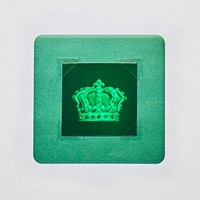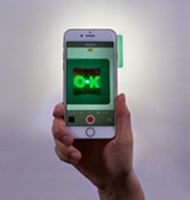Dai Nippon Printing Develops Lippmann Hologram That Generates Floating Text and Images When Irradiated with LED Light
Making It Easy to Determine Authenticity Using Smartphones
Dai Nippon Printing Co., Ltd., (DNP) has developed a novel Lippmann hologram*2 for authenticity determination that generates floating text and images when irradiated with an LED point source light.
[Features of the DNP LED Authentication Hologram for Lippmann holograms]
- Authenticity is readily determined by inspecting floating text and pictures generated by irradiating with point source light, including LED light sources.
- Compared to embossed holograms*2, the DNP LED Authentication Hologram minimizes color variance in images for clearer, sharper images.
- The technology allows determination of authenticity using handheld LED devices or LED light from smartphones.*4 This eliminates the need to purchase microscopes and special films and reduces introduction costs.
- Authentication results can be readily captured using cameras on smartphones or other devices and sent by email to the relevant parties in distant locations.
- Hologram security can be enhanced by combining this product with other security technologies, including “micro-printing” technologies, which print specific information onto a hologram using minute characters.


Text and pictures appear to float above the surface of the hologram when irradiated with LED light.
[Future Prospects]
DNP plans to make this product available for applications requiring high security performance, including IDs, passports, and drivers’ licenses. DNP plans to achieve sales of 200 million yen in FY2020.
*1 “DNP LED Authentication Hologram”
https://www.global.dnp/news/detail/20167044_4126.html
*2 Embossed hologram: Hologram that records optical interference patterns by embossing fine patterns on the surface of a film. Viewed from varying angles, the hologram assumes the various colors of the visible spectrum, enabling 3D expression in the left-right direction.
*3 Lippmann hologram: Interference patterns are recorded onto layers of special polymers coated onto a film as differences in refractive indices. When light is irradiated onto these interference patterns, the resulting diffraction reproduces the recorded holographic image. The Lippmann hologram offers superior 3D images particularly in the dimension of depth when the line of sight is tilted in the vertical and lateral directions. This results in highly realistic holographic visual reproduction of objects. Lippmann holograms require sophisticated reproduction technologies; few manufacturers anywhere in the world are capable of mass-producing Lippmann holograms.
*4 The type of LED light used and image capture conditions may affect ease of authentication.
* Product prices, specifications and service contents mentioned in this news release are current as of the date of publication. They may be changed at any time without notice.
- Select location
-
- Category
-